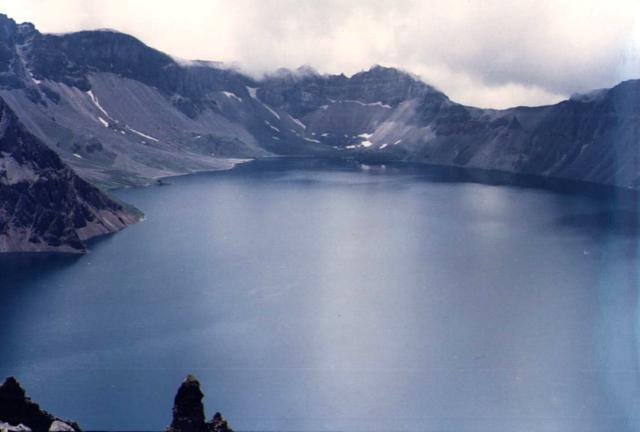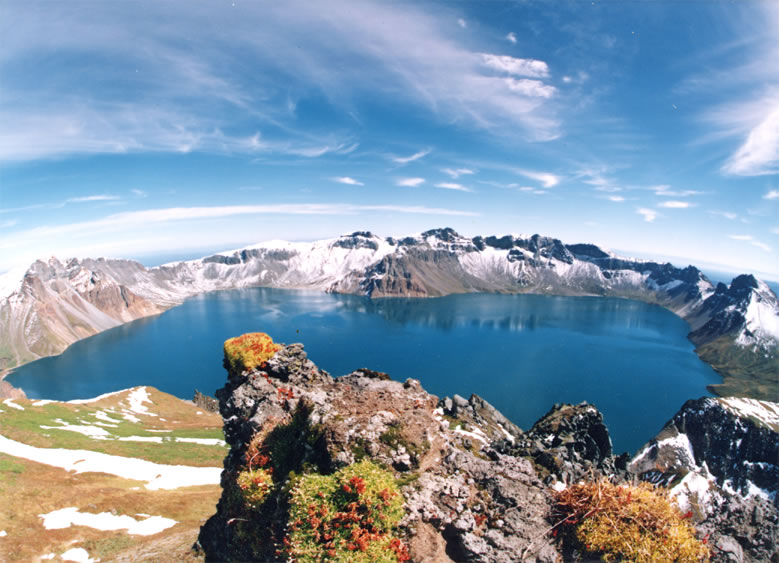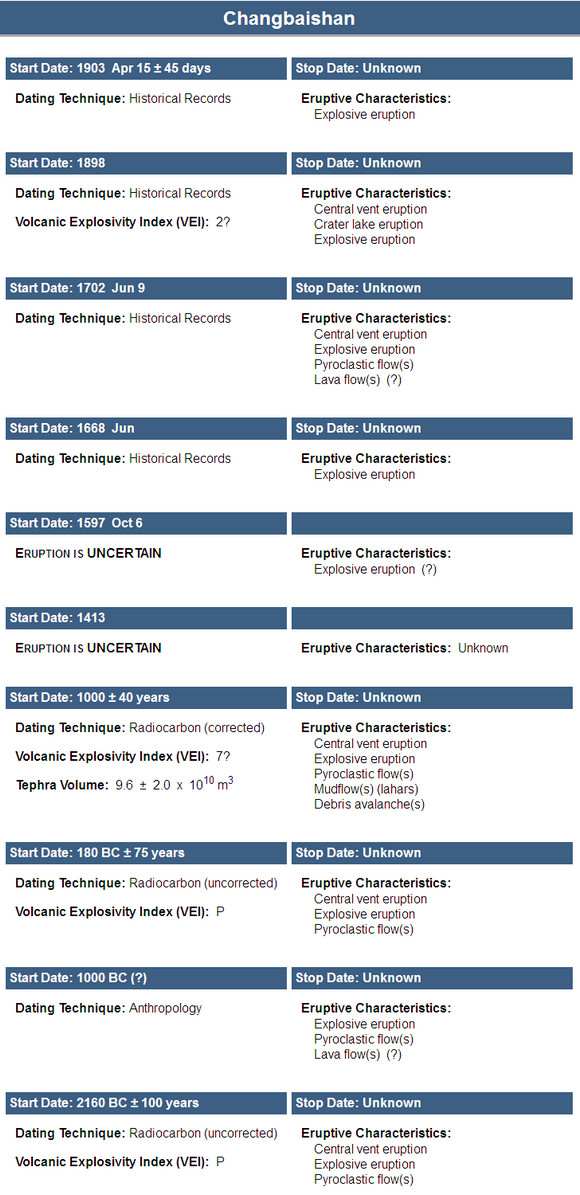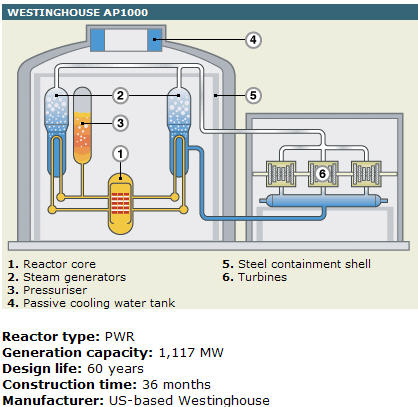It looks like you're using an Ad Blocker.
Please white-list or disable AboveTopSecret.com in your ad-blocking tool.
Thank you.
Some features of ATS will be disabled while you continue to use an ad-blocker.
share:
I know this has been on the cards for a while, but it seems the spectre of a big eruption looming is raising it's head again.
Source: Ice Age Now
It has been calculated that the last big eruption was VEI 7 which makes it not a supervolcano but going up that way.
Smithsonian says:

[www.volcano.si.edu...]Image Source[/url]
Photo by Xiang Liu, 1983 (Changchun University).
Personally I rather like the picture in Wikipedia

Image Source
长白山天池 Took it myself. (del) (cur) 22:50, 17 June 2005 . . Bdpmax (104130 bytes) (长白山天池) [[GFDL]]
There is more information and a couple of photographs on this site: crienglish.com
The volcano's eruptive history (from the Smithsonian Institute referenced above)

This was last discussed on ATS over a year ago in this thread so I thought it time to bring the subject back into the limelight.
Now, aside from the pretty pictures we get down to the nitty gritty. Most of the information below is on the original Ice Age Now link I posted BUT on important element is missing which I have highlighted below.
Potential Nuclear Disaster
Source: Korean Times
Geologist Yoon Sung-hyo at Pusan National University strongly believes Mt. Baekdu could erupt any time soon.
Source: Ice Age Now
Concern is growing about a possible eruption of Mt. Baekdu, the highest mountain on the Korean Peninsula, says this article by Park Chang-seok.
A South Korean geological expert has warned that the volcano – which last erupted in 1702 – could erupt sometime around 2014 and 2015.
If the volcano, located on the border between North Korea and China erupts, damage could be 10 to 100 times greater than that caused by the April 2010 eruptions in Iceland.
It has been calculated that the last big eruption was VEI 7 which makes it not a supervolcano but going up that way.
Smithsonian says:
Massive Changbaishan stratovolcano, also known as Baitoushan and by the Korean names of Baegdu or P'aektu-san, is a relatively poorly known, but volcanologically significant volcano straddling the China/Korea border. A 5-km-wide, 850-m-deep summit caldera is filled by scenic Lake Tianchi (Sky Lake).

[www.volcano.si.edu...]Image Source[/url]
Photo by Xiang Liu, 1983 (Changchun University).
Personally I rather like the picture in Wikipedia

Image Source
长白山天池 Took it myself. (del) (cur) 22:50, 17 June 2005 . . Bdpmax (104130 bytes) (长白山天池) [[GFDL]]
There is more information and a couple of photographs on this site: crienglish.com
The volcano's eruptive history (from the Smithsonian Institute referenced above)

This was last discussed on ATS over a year ago in this thread so I thought it time to bring the subject back into the limelight.
Now, aside from the pretty pictures we get down to the nitty gritty. Most of the information below is on the original Ice Age Now link I posted BUT on important element is missing which I have highlighted below.
Potential Nuclear Disaster
Mt. Baekdu’s caldera has nearly two billion tons of water. If volcanic heat evaporates the water and is mixed suddenly with volcanic ashes, it would be strong enough to engulf even Vladivostok in Russia and Hokkaido in northern Japan, according to experts. The construction of nuclear power plants by North Korea and China in the neighborhood may certainly pose a grave threat to all Northeast Asians, with the view that Mt. Baekdu’s explosion would for sure cause subsequent nuclear catastrophes, as seen in Japan’s 2011 tsunami disaster. A volcanic explosion is the most terrible natural disaster which cannot be easily avoided by human wisdom and knowledge.
With unrelenting outbreaks of record-breaking natural disasters around the world and especially in the wake of Japan’s massive earthquake that is now estimated to have killed nearly 10,000, the world’s eyes are drawn to Mt. Baekdu. Multinational and regional cooperative monitoring systems are needed beyond ideological barriers to take preemptive measures against a possible eruption.
By all indications, Mt. Baekdu is a real danger and it’s not clear how long it will stay inactive. A Mt. Baekdu eruption, if it takes place, will not be a matter for a certain country but a global concern to determine the future of Northeast Asian civilization.
Source: Korean Times
edit on 5/5/2012 by PuterMan because: to fix a tag
I wonder if they sense that their demise is coming that they'll just say "The hell with it" and nuke S. Korea or something.
I wasn't aware of this particular volcano, nor that there were nuclear facilities in the area. That's just great. Thanks for the post.
Oh can it really be this easy? Can we just watch Nature cast her vote on North Korean leadership and simply be done with the problem? I wonder... How
large an area would that effect with downwind being out to Sea for at least a distance, anyway?
Anyone know what if there is a Volcano dance, similar to the Rain Dance? It's worth a shot... People could line up at the DMZ and do the little dance in hopes Nature will reply..
Speaking of the little fireplug in the North, what is up with that Nuclear Weapons test they were making threats about after that Missile test went bad for them? Their luck has been like this too....it's about the only thing BAD that North Korea hasn't had happen. Mr Murphy hates such a lapse...
Anyone know what if there is a Volcano dance, similar to the Rain Dance? It's worth a shot... People could line up at the DMZ and do the little dance in hopes Nature will reply..
Speaking of the little fireplug in the North, what is up with that Nuclear Weapons test they were making threats about after that Missile test went bad for them? Their luck has been like this too....it's about the only thing BAD that North Korea hasn't had happen. Mr Murphy hates such a lapse...
Well if it does erupt and destroy the country, it'll save America a job lol.
Sure would be nice to have a few of those volcano's to spare....Maybe one for Iran...
Growing fears?
Maybe itll take out lil kimmy
while it blows up, be the best
thing for the world, gurantee it.
Maybe itll take out lil kimmy
while it blows up, be the best
thing for the world, gurantee it.
S&PF Puterman!
Another well-crafted thread filled with relevant data and insightful commentary!
As with many others, I was unaware of this particular volcano so I'm now off to do some additional reading.
Clever rabbit..."little fireplug" caused me to spew coffee all over my desk!
And we're it not for the nuke facilities in close proximity (does this industry specifically hire idiots?) I would join the line for your aforementioned volcano dance...
Another well-crafted thread filled with relevant data and insightful commentary!
As with many others, I was unaware of this particular volcano so I'm now off to do some additional reading.
Clever rabbit..."little fireplug" caused me to spew coffee all over my desk!
And we're it not for the nuke facilities in close proximity (does this industry specifically hire idiots?) I would join the line for your aforementioned volcano dance...
edit on 5-5-2012 by jadedANDcynical because: Hat would be F, not P...stupid autocorrect...
reply to post by Another10Pin
I think many are not aware of the volcano basically because there is not any recent history.
I was unaware of the nuclear element until today I must say.
reply to post by jadedANDcynical
Thank you jAc. Please do come back and report any additional information. I am not up in the nuclear side of things so anything on that aspect would be appreciated.
I wasn't aware of this particular volcano, nor that there were nuclear facilities in the area. That's just great. Thanks for the post.
I think many are not aware of the volcano basically because there is not any recent history.
I was unaware of the nuclear element until today I must say.
reply to post by jadedANDcynical
Thank you jAc. Please do come back and report any additional information. I am not up in the nuclear side of things so anything on that aspect would be appreciated.
edit on 5/5/2012 by PuterMan because: (no reason given)
reply to post by PuterMan
China to build nuclear power plants at Mount Baekdu
If it goes off, they're potentially reaping what they've sown:
Mt. Baekdu eruption’s impact on NE Asia (25)
Looking for more info, as in what types of reactors etc...
The Chinese nuclear development news network announced earlier this year that the Chinese government will start building four 1,250-megawatt nuclear reactors in Jingyu County, Baishan City, Jilin Province, and plans to operate them in March 2016. They are located about 100 kilometers from Mount Baekdu.
...
“The trophospheric westerlies blow from China to Korea most of the year, the jet stream in the stratosphere all year round,” Jeong Jun-seok, director of the Climate Prediction Division at the Korea Meteorological Administration, said. “In case of an accident in nuclear plants in China, radioactive materials are highly likely fly to the Korean Peninsula.”
China to build nuclear power plants at Mount Baekdu
If it goes off, they're potentially reaping what they've sown:
emphasis mine
On Oct. 1, 2006, a Russian satellite found the surface temperature of the mountain notably higher than before. The finding came just days after North Korea conducted an underground nuclear test in its northern territory, which could have been a catalyst reactivating magma flows, according to analysts.
Mt. Baekdu eruption’s impact on NE Asia (25)
Looking for more info, as in what types of reactors etc...
you just had to make a new thread on her did nt ya? brat..
iv been busy working and got my mind on other things...
thank you the update pm , and must admit i like your thread better n mine lol..
ill have a looksee later into this again..
and thank you for giving a heads up to my thread... i appreciate it..
iv been busy working and got my mind on other things...
thank you the update pm , and must admit i like your thread better n mine lol..
ill have a looksee later into this again..
and thank you for giving a heads up to my thread... i appreciate it..
reply to post by jadedANDcynical
WHAT??!!! Just when I thought I had it figured out, something else proves just how REALLY crazy the human race is.
Thanks for the heads up PM....as if mother nature isn't danger enough, we have to go and build nuclear plants practically on top of these ticking time bombs...geesh....
WHAT??!!! Just when I thought I had it figured out, something else proves just how REALLY crazy the human race is.
Thanks for the heads up PM....as if mother nature isn't danger enough, we have to go and build nuclear plants practically on top of these ticking time bombs...geesh....
Hey Puterman,
how many volcanoes is it now?
How many sleepers have awakened in the last 2 years?
how many volcanoes is it now?
How many sleepers have awakened in the last 2 years?
reply to post by Lil Drummerboy
Not sure. I have it in mind to have a count up to see what is imminent according to the scientists.
Not sure. I have it in mind to have a count up to see what is imminent according to the scientists.
Great,.
Originally posted by PuterMan
reply to post by Lil Drummerboy
Not sure. I have it in mind to have a count up to see what is imminent according to the scientists.
I look forward to it..hisz.rsoe.hu...
i know some are on here but there are others im sure
reply to post by jadedANDcynical
Got it!
China Plans to Build Power Plants at Baekdu
Be back with details in a few minutes; have to switch to my main comp from iPhone.
ETA
Here is a simplified schematic of the AP-1000:

Here is an isometric cross section with more detail:

AP1000 At a Glance
Advanced Nuclear Power Reactors
Well in reading about Gen III reactors, it seems as though there have been a number of safety features included in the overall design. But then again all of that is written by the companies which produce the reactor designs and thus read more like R/advertisements than objective analyses.
I smell a rat...
Westinghouse Sold AP1000 Technology Developed With American Taxpayer Assistance to China More than Three Years Ago
So Westinghouse develops this technology with money from US taxpayers and then sells the end result of that R&D to China. China has a history of copying technologies and then repackaging that as their own which it then turns around and sells to others.
Am I the only one who thinks that there is something wrong with this?
Got it!
The Korea Energy Economics Institute says China's Jilin Province has announced that it will launch the power plant project in 2012. Some 85 billion yuan, or 14-point-five trillion South Korean won, will be used to build six, 12-hundred-50 megawatt AP-1000 reactors.
AP-1000 is a pressurized water reactor developed by the U.S. firm Westinghouse.
China Plans to Build Power Plants at Baekdu
Be back with details in a few minutes; have to switch to my main comp from iPhone.
ETA
Here is a simplified schematic of the AP-1000:

Here is an isometric cross section with more detail:

AP1000 At a Glance
So-called third-generation reactors have:
> a standardised design for each type to expedite licensing, reduce capital cost and reduce construction time,
> a simpler and more rugged design, making them easier to operate and less vulnerable to operational upsets,
> higher availability and longer operating life - typically 60 years,
> further reduced possibility of core melt accidents,*
> substantial grace period, so that following shutdown the plant requires no active intervention for (typically) 72 hours,
> resistance to serious damage that would allow radiological release from an aircraft impact,
> higher burn-up to use fuel more fully and efficiently and reduce the amount of waste,
> greater use of burnable absorbers ("poisons") to extend fuel life.
* The US NRC requirement for calculated core damage frequency is 1x10-4, most current US plants have about 5x10-5 and Generation III plants are about ten times better than this. The IAEA safety target for future plants is 1x10-5. Calculated large release frequency (for radioactivity) is generally about ten times less than CDF.
...
The AP1000 generating costs are also expected to be very competitive and it has a 60-year operating life. It is being built in China (4 units under construction, with many more to follow) and is under active consideration for building in Europe and USA. It is capable of running on a full MOX core if required.
Advanced Nuclear Power Reactors
Well in reading about Gen III reactors, it seems as though there have been a number of safety features included in the overall design. But then again all of that is written by the companies which produce the reactor designs and thus read more like R/advertisements than objective analyses.
I smell a rat...
This morning, my Google News Alert indicated that MSNBC and Bloomberg had both noticed that Westinghouse had transferred 75,000 documents relating to the design and construction of AP1000 nuclear reactor plants to China. One of those sources linked to a November 23, 2010 Financial Times report titled US group gives China details of nuclear technology.
Neither one of them linked to a June 2007 article titled China may export technology learned by building modern reactors that warned about the implications of a signed technology transfer agreement that was an integral part of Westinghouse’s sale of four AP1000s in March of 2007.
I guess it is not too surprising that this week’s reports are being portrayed as news since that early warning appeared on an obscure blog run by a guy who is not part of the mainstream media or a recognized contributor to the business press. There is also the distinct possibility that vain Western business leaders are finally waking up to the fact that it is a bad idea to sell the end results of decades worth of creative thinking to a group of expert copiers who have access to a vast number of extremely poor people willing to work hard for wages that would lead to starvation in most developed countries.
Westinghouse Sold AP1000 Technology Developed With American Taxpayer Assistance to China More than Three Years Ago
So Westinghouse develops this technology with money from US taxpayers and then sells the end result of that R&D to China. China has a history of copying technologies and then repackaging that as their own which it then turns around and sells to others.
Am I the only one who thinks that there is something wrong with this?
edit on 5-5-2012 by jadedANDcynical because: additional info
reply to post by jadedANDcynical
Excellent work jAc and thanks again for you diligence.
Do you think it would be reasonable to suggest that perhaps if these nukes are only just starting to be bulit then perhaps the threat is not as great (this time round!)
Excellent work jAc and thanks again for you diligence.
Do you think it would be reasonable to suggest that perhaps if these nukes are only just starting to be bulit then perhaps the threat is not as great (this time round!)
new topics
-
F-18 shot down over Red Sea....by our own Destroyer?
Other Current Events: 55 minutes ago -
California Business Owners Blindsided by Surprise Payroll Taxes
US Political Madness: 1 hours ago -
Anti-Government Protest in Serbia
Social Issues and Civil Unrest: 6 hours ago -
The Effects of Electric Fields and Plasma on Plant Growth
Science & Technology: 7 hours ago
top topics
-
California Business Owners Blindsided by Surprise Payroll Taxes
US Political Madness: 1 hours ago, 13 flags -
NYPD Chief Jeffrey Maddrey Resigns - Forced Officers to Give Sex for Overtime Pay and Favors.
Posse Comitatus: 16 hours ago, 11 flags -
Swarms of tiny 'ant-like' robots lift heavy objects and navigate obstacles
Science & Technology: 15 hours ago, 6 flags -
The Effects of Electric Fields and Plasma on Plant Growth
Science & Technology: 7 hours ago, 6 flags -
Anti-Government Protest in Serbia
Social Issues and Civil Unrest: 6 hours ago, 6 flags -
The Daily Mail trying to imply “it’s aliens”
Dissecting Disinformation: 14 hours ago, 4 flags -
F-18 shot down over Red Sea....by our own Destroyer?
Other Current Events: 55 minutes ago, 2 flags
active topics
-
California Business Owners Blindsided by Surprise Payroll Taxes
US Political Madness • 4 • : charlest2 -
-@TH3WH17ERABB17- -Q- ---TIME TO SHOW THE WORLD--- -Part- --44--
Dissecting Disinformation • 3785 • : Thoughtful3 -
F-18 shot down over Red Sea....by our own Destroyer?
Other Current Events • 5 • : watchitburn -
Anti-Government Protest in Serbia
Social Issues and Civil Unrest • 5 • : Imhere -
Drones everywhere in New Jersey ---and Elsewhere Master Thread
Aliens and UFOs • 225 • : Ravenwatcher -
NYPD Chief Jeffrey Maddrey Resigns - Forced Officers to Give Sex for Overtime Pay and Favors.
Posse Comitatus • 10 • : xuenchen -
Labour Plotting to Postpone May's Council Elections ?
Regional Politics • 12 • : gortex -
‘Something horrible’: Somerset pit reveals bronze age cannibalism
Ancient & Lost Civilizations • 14 • : Scratchpost -
China Working on 'Drone Mothership' Plane
Military Projects • 8 • : Scratchpost -
Democrat Leader Hakeem Jeffries Promotes HATE After 2nd Attempt to Murder Trump in 2024.
US Political Madness • 44 • : marg6043
